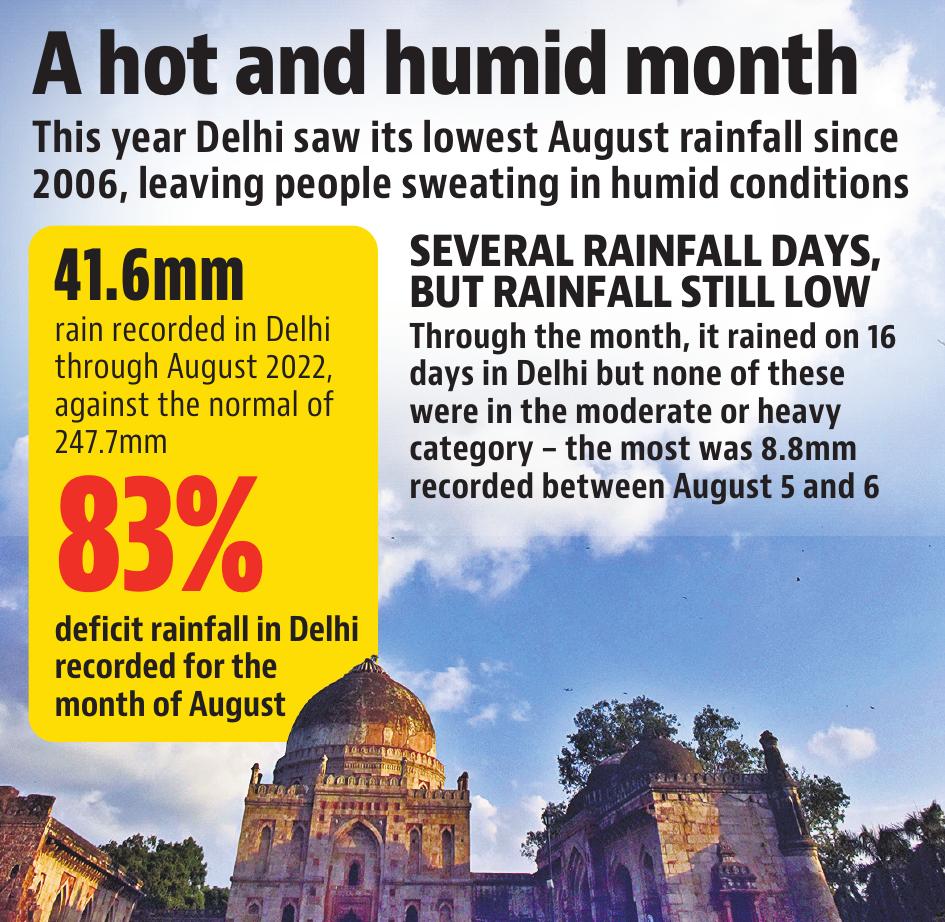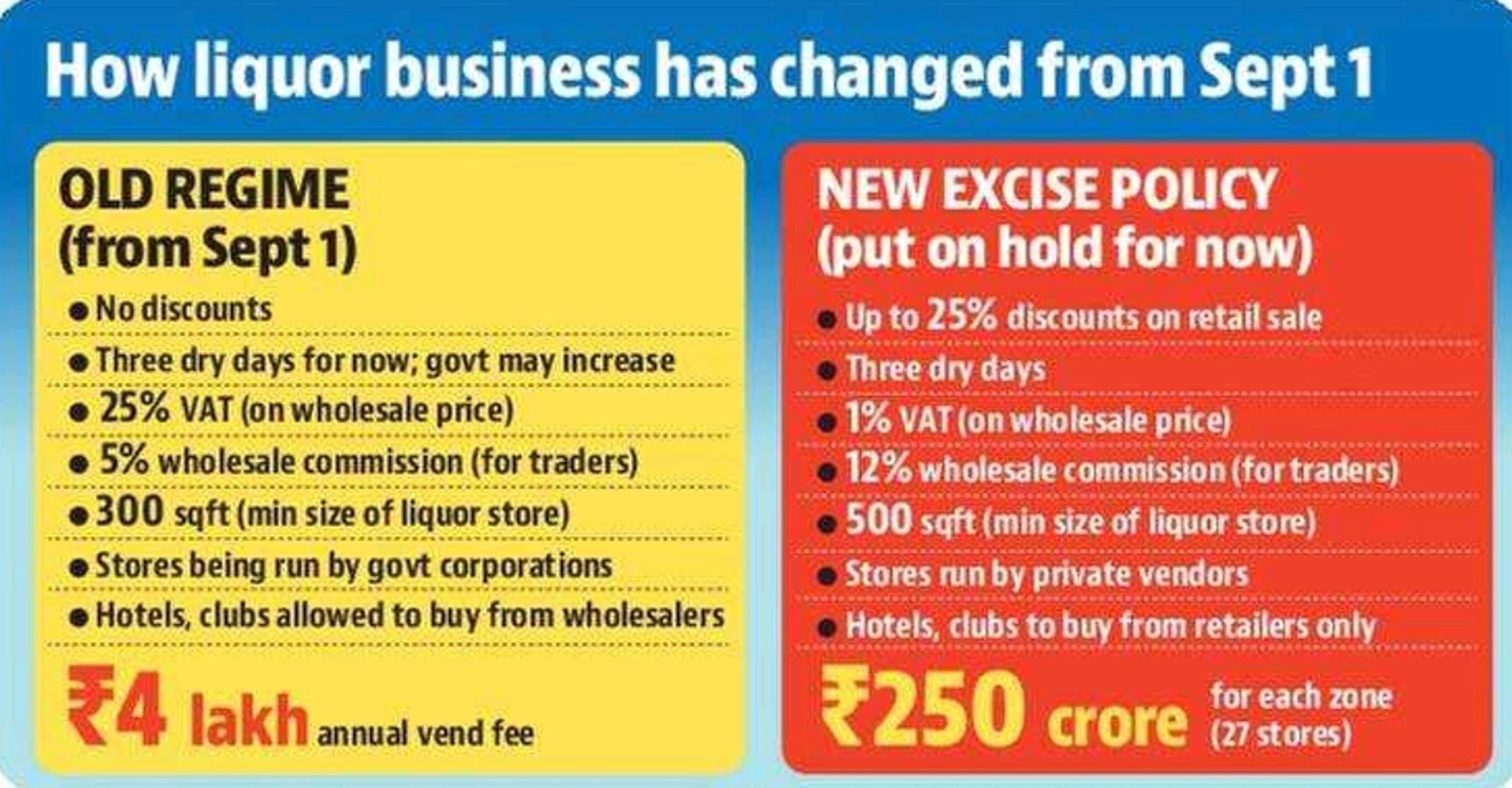| The crime, the Covid, the politics and the potholes: Capital Letters — Keeping track of Delhi's week, one beat at a time, through the eyes and words of HT's My Delhi section, with all the perspective, context and analysis you need. Good morning! If you live in Delhi, or the NCR even, you’ve probably noticed that it’s been an unnaturally dry August (in terms of rain, we’ll get to the liquor shortage in a bit). The month is usually Delhi’s wettest, giving Delhi more than one-third (247.7mm) of its normal 650mm-odd monsoon rain. But, ominously, the Capital got just 41.6mm of showers all month, leaving it with an 83% rain deficit, making this the driest August in at least 16 years. Why? You’ve probably heard the answer before: Dramatically changing climate patterns. Keep in mind that the record dry August this year came after a properly wet July, which saw excess rain (286.3mm of rain, instead of the normal 210.6mm). It’s also worth noting that August last year ended with a rain deficit (214.5mm), but still much closer to the normal. But there’s another layer to this: Most of the rain in July this year and in August last year came over just a couple days of showers, leaving most of the month dry. So, month-wise figures are probably no longer a decent metric to understand rainfall patterns. (And we aren’t even getting into rain distribution on a neighbourhood-wise level, where divergences are getting wider). And yet, all of this said, August was strangely dry for Delhi, and indeed large parts of northern India. Neighbouring Uttar Pradesh, for instance, got just 56% of its usual August rain this year, while Punjab got 41% and Haryana got 48%.  (Click to expand) Experts, as mentioned earlier, have pinned this on the potential impact of the climate crisis, which is manifesting itself in local meteorological factors: For instance, the monsoon trough (a zone of active rain) spent a lot of time closer to the south, depriving the north of rain. The rain deficit for north India is unlikely to be bridged soon and will severely impact food production, especially across the country’s paddy belt. The June-September monsoon waters nearly 60% of India’s net sown area, and weak rain is likely to have far-reaching consequences for a country that came off a record hot March, which severely impacted wheat production. A drop in food production may also act as a leg-up for inflation. September has, so far, been slim-pickings in rain terms, so the monsoon may just end with a whimper. But hey, it’s the anthropocene, so it isn’t over till it’s over. The rooms with the views With the Apex and Ceyane towers wiped from Noida’s skyline, residents of societies neighbouring the demolished buildings are still getting used to two new sights - one, a view of of all the adjacent greenery, which was blocked the behemoths, and two, a huge pile of debris that won’t be flattened till November at least. With the illegal towers now gone, residents of Noida’s Sector 93A have begun to soak in the glory of a long battle won, but also truly come to terms with the major clean-up job that awaits (the latter stands true for residents of the neighbouring ATS Greens Village society as well). Hundreds of labour workers, several cranes, and countless trucks are at work ceaselessly to ensure the roughly 25,000 metric tonnes of debris to be cleared in the wake of the demolition is packed off to a private landfill nearby, where it will be reused or rid off. In the immediate aftermath of the demolition, pollution levels in the neighbourhood shot off the charts, according to data from air quality monitors installed by state authorities within a kilometre of the blast radius. The closest of these was installed at Parsvnath Prestige, just a few hundred metres away from the towers. Here, levels of PM10 (a pollutant composed primarily of dust) a day ahead of the demolition peaked at an eight-hour average of 81µg/m3 between 2pm and 10pm, the data showed. The towers fell at 2.30pm on Sunday and PM10 levels in the corresponding period rose more than eight times, rocketing up to a hazardous 676µg/m3, before plummeting by two-thirds to 230µg/m3 by Monday morning. Pollution levels dropped even further between 2pm and 10pm on Monday, helped by a largely continuous spell of showers that continued till late night, with the reading at Parsvnath Prestige dipping to 137µg/m3.  (Click to expand) But one question remains: What will come up at the spot where the towers stood? A green area? A temple? Another housing structure? This one is still up in the air and will depend on the concurrence of the developer (Supertech) and the Noida administration. Till then, residents of the neighbouring ATS Greens Village, who have so far been exemplary neighbours, are now saying they may have won the short end of the stick, bearing a lot of damage for a fight that wasn’t strictly even theirs. STORIES YOU MAY HAVE MISSED No holds barred Escalating tensions between the elected Aam Aadmi Party (AAP) government in Delhi and the Bharatiya Janata Party (BJP) seem to reach new heights every day. This battle has found its way to the 70-member state assembly, where the AAP enjoys a 62-MLA brute majority. The party this week won a trust vote it floated, a display of unity it used to to claim that the BJP’s attempts to impose ‘Operation Lotus’ in Delhi and topple the state government had failed. Deputy chief minister Manish Sisodia claimed on Tuesday that the CBI has given him a “clean chit” because they found “nothing” incriminating during the earlier raid at his residence and after searching a bank safe deposit box on Tuesday. To be sure, CBI has not said anything about what it found or did not find in the safe deposit box at the locker. Nor has it said anything about the ongoing investigation. Meanwhile, as each party tried to one-up each other with protests on the streets, Delhi’s lieutenant governor VK Saxena became the subject of corruption allegations from the AAP. The Arvind Kejriwal-led party accused Saxena of a ‘notes scam’ while he was chief of the Khadi and Village Industries Commission (KVIC). Saxena, the party alleged, “pressured his employees to exchange demonetised notes worth ₹1,400 crore in 2016 and thus was involved in the scam”. The LG, for his part, hit back and said he would sue AAP leaders for the “false, derogatory” claims. Then, each party began inspecting each others’ schools, as education in Delhi became the focus of another set of counter-allegations. First, BJP spokesperson Gaurav Bhatia set off to inspect AAP-government run schools. The AAP’s Greater Kailash MLA Saurabh Bharadwaj then invited him to go around the city and get a glimpse of the Kejriwal government’s work on education. And then, the two leaders faced-off on a street in south Delhi. And then, both released videos to prove they had one-upped the other. Bhatia said the AAP and Bharadwaj were shying away from providing the list of 500 schools that they claim have been constructed. “I sought the list of 500 schools on multiple occasions but it was not provided. I was shown an old school that was claimed to have been built by the AAP. Their lies were caught,” Bhatia said. To this, Bharadwaj said Bhatia claimed during the debate that no new school was constructed. “He came to a school at Greater Kailash-1 but did not enter the building as it was full of parents. Then we arrived at a second site where a new school is being constructed, but he just ran away. He asked me to provide the list of 500 schools. I wanted him to see each unit with me but he merely insisted that I hand over the list of 500 schools.” This, of course, went on. Then, the AAP inspected civic-body run schools in the city and flagged allegedly poor construction and a lack of teachers. All of this erupted and bubbled away even as the state’s new, old liquor policy kicked in.  (Click to expand) Around 300 shops have been opened under the new regime, but stocks are still few and far between, while discounts are a thing of the past. The government is, of course, hopeful that these will be ironed out in the coming days and weeks, and that Delhi can look at an efficient, short-term model where state-run liquor vends can sustain demand for the Capital, till alternate arrangements are made. |